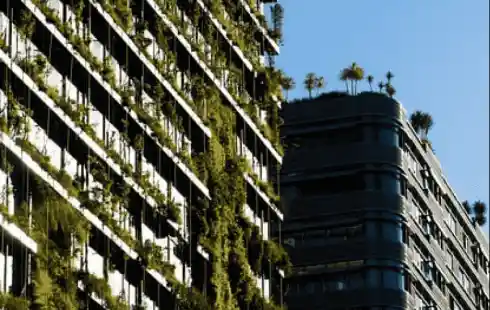
Revolutionising Websites for Cafés, Restaurants, and Bars Across Europe
Section: News
 Imagine a city where buildings aren't just structures of steel and concrete but living entities that breathe, grow, and adapt to their environment. This is not a scene from a science fiction novel, but a rapidly emerging trend in modern architecture known as "living architecture." As the world grapples with climate change and urbanization, the innovative concept of buildings that harmonize with nature is capturing imaginations and transforming skylines. Let's delve into this fascinating movement and explore how it is reshaping our cities and our relationship with the environment.
Imagine a city where buildings aren't just structures of steel and concrete but living entities that breathe, grow, and adapt to their environment. This is not a scene from a science fiction novel, but a rapidly emerging trend in modern architecture known as "living architecture." As the world grapples with climate change and urbanization, the innovative concept of buildings that harmonize with nature is capturing imaginations and transforming skylines. Let's delve into this fascinating movement and explore how it is reshaping our cities and our relationship with the environment.
Living architecture integrates natural elements and biological processes into the design and function of buildings. It goes beyond green roofs and vertical gardens to incorporate advanced technologies and bioengineering, creating structures that can self-sustain, self-repair, and interact with their surroundings. These buildings are not just environmentally friendly; they are part of the ecosystem.
Key Innovations
Bio-Concrete: One of the most groundbreaking developments in living architecture is bio-concrete, a material embedded with bacteria that produce limestone when exposed to water. This allows the concrete to heal its own cracks, extending the lifespan of the building and reducing maintenance costs. Researchers at Delft University of Technology in the Netherlands have been pioneers in this field, creating self-healing concrete that could revolutionize construction.
Algae Facades: Algae facades are another innovative feature of living buildings. These facades use panels filled with microalgae that can capture CO2 and produce oxygen, effectively turning the building into a giant air purifier. Additionally, the algae can be harvested and converted into biofuel, providing a renewable energy source for the building. The BIQ House in Hamburg, Germany, is a prime example, showcasing the potential of algae facades to make urban environments more sustainable.
Urban Biodiversity: Living architecture promotes biodiversity in urban areas by incorporating habitats for plants, insects, and birds into building designs. Green walls, rooftop gardens, and integrated water systems create micro-ecosystems that support wildlife and enhance the ecological value of cities. These features not only beautify urban spaces but also improve air quality and reduce the urban heat island effect.
The impact of living architecture extends beyond environmental sustainability. It fosters a healthier, more enjoyable urban experience for residents and visitors. Here's how:
Enhanced Well-being: Integrating natural elements into buildings has been shown to reduce stress, improve mental health, and boost productivity. Access to green spaces and nature within urban settings provides a respite from the concrete jungle and contributes to overall well-being.
Climate Resilience: Living buildings are better equipped to withstand the effects of climate change. Green roofs and walls act as insulation, reducing energy consumption for heating and cooling. Water systems that recycle rainwater help manage urban flooding and drought conditions.
Economic Advantages: While the initial investment in living architecture may be higher, the long-term economic benefits are substantial. Reduced energy and maintenance costs, increased property values, and potential revenue from biofuel production make living buildings a smart financial choice.
Despite its promise, living architecture faces several challenges. The complexity of integrating biological systems into buildings requires multidisciplinary collaboration and innovation. Maintenance of living elements and ensuring their resilience in varying climates are ongoing concerns. Additionally, widespread adoption depends on regulatory support and public acceptance.
However, as technology advances and awareness of environmental issues grows, the momentum behind living architecture is undeniable. Architects, urban planners, and scientists are increasingly working together to refine these concepts and bring them into mainstream construction. Cities like Singapore and Copenhagen are leading the way, showcasing stunning examples of living buildings that blend seamlessly with nature.
The rise of living architecture heralds a new era in urban development, where buildings are not just static structures but dynamic, life-enhancing entities. By embracing this innovative approach, we can create cities that are more sustainable, resilient, and harmonious with the natural world. As we continue to push the boundaries of what is possible in architecture, living buildings will undoubtedly play a crucial role in shaping a greener, healthier future for all. So, the next time you look at a skyscraper, imagine the possibilities of a structure that breathes, grows, and thrives along with its inhabitants.

Section: News

Section: News

Section: News

Section: Arts

Section: News

Section: News

Section: News

Section: News

Section: News

Section: Health

Health Insurance in Germany is compulsory and sometimes complicated, not to mention expensive. As an expat, you are required to navigate this landscape within weeks of arriving, so check our FAQ on PKV. For our guide on resources and access to agents who can give you a competitive quote, try our PKV Cost comparison tool.

Germany is famous for its medical expertise and extensive number of hospitals and clinics. See this comprehensive directory of hospitals and clinics across the country, complete with links to their websites, addresses, contact info, and specializations/services.

Come along to Italy... come along to the blue sea...With her Schlagershow, Petra Korn takes her audience on a musical journey through the 50s, 60s, and 70s, featuring her greatest hits and cult classics that are still well-known today. The singer and entertainer invites her audience to sing along...
No comments yet. Be the first to comment!